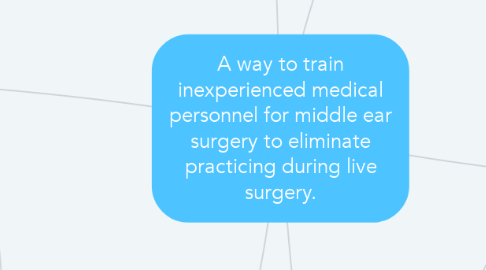A way to train inexperienced medical personnel for middle ear surgery to eliminate practicing during live surgery.
by Hannah Sobotka-Briner

1. Physical Ear Models
1.1. Silicone mold of Human ear
1.2. 3D print ear model
1.3. Scan potential patient's ear and 3D print
1.4. Mold the middle ear with an elastic thermo band
1.5. make custom model out of metal alloy
1.6. 3D print ear with different types of filament to mimic different ear tissues
1.7. Preform surgery on objects that mimic the ear
1.8. "Operation" style model with feedback system
1.9. Model inner ear with a series of tubes
1.10. Perform practice surgery on prosthetic ear
1.11. Have patients come in early and make personalized models to practice for specific patient
1.12. pour epoxy into the ear to make a mold
1.13. pour silicon into a live patient ear to make a mold for a model
1.14. Practice on an AI human model
1.15. Make a mechanical ear
1.16. 3D wax model
1.17. Use a mixture of 3D printing and PDMS to create realistic model
1.18. use calcium apatite to mimic done and use it to model the stapes, stirrup, and hammer
1.19. Use collagen to mimic the cartilage in the ear, use calcium apatite to mimic the bones, and PDMS to mimic the membranes
1.20. Use collagen to mimic the cartilage in the ear, use titanium to mimic the bones, and PDMS to mimic the membranes
1.21. Use pig stem cells to grow pig skin and overlay it on calcium apatite based bones
1.22. Combine salamander and human genes to create a durable cartilage for use in a training model
1.23. Combine pig and human genes to create a durable skin for use in a training model
2. Virtual ear models
2.1. Create VR middle ear model
2.2. Use sonar and VR to make hologram
2.3. create a virtual simulation that allows user to experience different parts of the surgery
2.4. Create a hologram of the human ear
2.5. Use several tiny cameras on different parts of the inner ear to create a 3D model of the ear
2.6. Create an app that reflects stapedectomy surgery
2.7. Make a video game to simulate surgery
2.8. An attachment for an otoscope that scans the inside of the ear and then produces hologram to practice on
2.9. Use holograms in a training program that would get progressively more difficult
2.10. Incorporate AI into a VR system to help guide user
2.11. Use chip devices in combination with VR to mimic a live surgery
2.12. Use an interactive touch screen to mimic the surgery
2.13. Only use the tools of the surgery (i.e. laser) in combination with VR to mimic the surgery
2.14. Use semi-set PDMS with hard markers with VR to simulate surgery
3. Technologies
3.1. Motion tracking glove + VR
3.2. Create a robot to perform surgery
3.3. Use AI to perform surgery
3.4. Create a mind control device
3.5. Create nanobots that can be externally controlled
3.6. Scan middle ear of patient and use robot to guide the resident through the surgery
3.7. A robot that can mimic a surgeon during surgery and can train through muscle memory
3.8. a machine that can mimic live movements of a surgeon so that med students can follow along
3.9. Shrink down students and walk them through the ear
3.10. Combine 3D model and VR model so resident can feel what the surgery would be like
3.11. Use a mechanical vibration to simulate stapes and therefore a live ear
4. Cadaver Ears
4.1. Fresh cadaver
4.2. Inject live stem cells into cadaver ear
4.3. inject fluid into a cadaver middle ear below footplate
4.4. put stem cells in the places middle ear tissue has died on cadaver
4.5. Kill patient
4.6. preserve ear in jar
4.7. cryogenically freeze body
4.8. A gas that dissolves everything on the cadaver except the ear/inner ear
4.9. Injectable serum that slows cell death
4.10. Remove inner ear and associated parts from cadaver and use mechanical device to hold elements in place
4.11. Inject serum that will refurbish inner ear by causing tissue to swell
4.12. Fresh animal cadavers
4.13. Use cadaver middle ear bones but use PDMS to simulate tissue
4.14. Use human bones and animal tissue
4.15. Build an incubation chamber to preserve the cadaver ear
5. Living Ear
5.1. Remove entire ear canal
5.2. Animal Testing
5.3. Grow human ear on live animal
5.4. Create human clones to practice on
5.5. Develop liquid injection drug to enlarge ear and make surgery easier
5.6. Liquid drug that would cure otosclerosis
5.7. Clone yourself
5.8. Clone patient and practice on them ahead of time
5.9. Grow a live ear on a scaffold
5.10. Build a scaffold with a 3D printer and seed with stem cells
5.11. Use stem cells to 3D print a human middle ear
5.12. Use a bovine graft to simulate live ears
5.13. Do an ear transplant
6. Techniques
6.1. Use DNA memorization
6.2. Use time travel to go back and fix errors
6.3. Use hypnosis to train personnel
6.4. Use electrical shocks to move the users' muscles specifically to do the surgery
6.5. Do Brain surgery on residents so they are "programmed" to know how to do the surgery
6.6. Have surgeons preform surgery on ear model while residents watch
6.7. Use a laser pointer to guide personnel through the surgery
6.8. Use a tiny camera to film surgery and walk personnel through it
6.9. Practice on your own ear
6.10. Auditory surgery walk through
6.11. Shock personnel when they make a wrong move
6.12. Attach electrodes to personnel and the surgeon and use electrical stimulus to force the untrained personnel to mimic the surgeon
6.13. Use mind control
6.14. Break surgery down into a series of small motions that can be taught
6.15. use telekinesis


